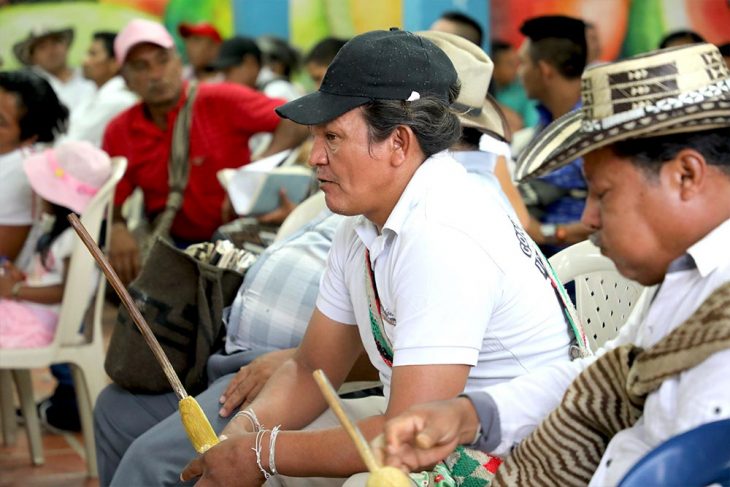The recent protests and violent crackdown in Colombia reveal why it is so important not only to defend the implementation of the 2016 Peace Agreement but also put into practice one of its most innovative elements: the inclusion of a restorative justice approach in the investigation of human rights violations. As a Colombian lawyer working on the protection of human rights, I have witnessed how human rights abuses in my country threaten to derail the peace process. Despite the criticism surrounding restorative sanctions, such measures could heal these societal wounds and bring about a sustainable peace.
In Colombia, the creation of several mechanisms with an underlying principle of restorative justice, most notably the Special Jurisdiction for Peace (JEP), opened up a real possibility for innovative criminal procedures to overcome many of the shortcomings of retributive justice and embrace an approach that truly puts victims at the centre. Effectively using the special restorative sanctions, or sanciones propias, would bring deeper meaning to victim participation and healing among communities. This moment is getting closer as on 30 April 2021, eight former Revolutionary Armed Forces of Colombia (FARC) commanders acknowledged their responsibility for the crime of taking hostages in the context of Case 01.
Victim-centred justice
Despite this accountability milestone for Colombian history, it is important to remember that a genuine restorative justice approach does not merely rely on sentencing, but also on all the previous steps taken within the investigation and prosecution of human rights violations. These steps include how victims are interviewed and treated in judicial proceedings, for what purposes they are called to intervene in court, how victims are repaired, among other key issues which must demonstrate that attention has truly shifted from focusing only on the criminal responsibility of perpetrators to victims’ demands.
To this end, the Colombian case has already set an important precedent in terms of its design by giving accountability a different purpose. The Peace Agreement established the JEP which is a judicial body that – in a unique way for a tribunal that is bound to apply international law – manages to combine a retributive and a restorative justice approach, as both are equally needed. It establishes that institutions need to place special emphasis on restorative and reparative measures and “seek to achieve justice not only through retributive sanctions”. Thus, from a retributive approach, the Agreement establishes an effective possibility of restriction of liberty. It allows for long periods of imprisonment in cases of non-compliance, which can go up to 20 years under ordinary prison conditions. On the other hand, from a restorative justice approach, the Colombian model introduced special restorative sanctions that can only be imposed if perpetrators acknowledge their responsibility and tell the truth.
Such stipulations allow the JEP to impose, on a case-by-case basis, penalties with a reparative effect on victims’ lives taking into account their demands and concerns. The JEP must ensure that sanctions benefit communities by redressing the social exclusion caused by the human rights violations that took place. The Agreement contains a list of penalties including sentencing perpetrators to rebuild schools, roads, health centres and other facilities that were destroyed by them during armed attacks.
Bolstering victim participation
The Agreement also substantively fosters victims’ participation, which is usually one of the main shortcomings of retributive approaches. Given that the goal of trials is to determine whether a person has committed a crime and to what extent they were implicated, very often victims are only called to testify to fit those purposes. However, the Colombian model – which under the Peace Agreement consists of the JEP, as well as the Truth Commission and the Missing Persons Unit – truly puts victims in the centre.It includes innovative ways of ensuring this restorative impact, for instance, by establishing mechanisms for consulting with victims on which restorative sanctions should be imposed, what they mean to them and how they should be applied.
Such consultations have already started, as victims can submit reports about the crimes suffered in writing and orally. This major accomplishment in itself has already demonstrated that, beyond the specific penalty imposed on perpetrators, empowering victims and giving them agency is a key step in terms of what a restorative process must be. For example, during many of the testimonies provided by victims within the JEP’s Case 01 on hostage-taking, magistrates have asked victims about these sanctions and how, in their opinion and despite the terrible pain they suffered, those penalties should look like in practice. These types of consultations have had an unprecedented value for victims.
“In the past, victims hadn’t been the centre of the process. We hadn’t felt that way. Thus, I have accepted to come forward before the JEP because I feel that the JEP puts victims in the centre and not perpetrators. Perpetrators can’t be the main protagonists of a peace process,” said Consuelo González de Perdomo, a former congresswoman who was kidnapped by the FARC for almost seven years.
Weathering the criticism and rebuilding relationships
The restorative justice approach has faced criticism given that it has traditionally been used to address ordinary and minor crimes in societies. In many jurisdictions, for example, young people who were involved in minor first-time offences are made to do community service to repair the harm they have done. Thus, according to some, applying restorative justice to a context in which massive human rights violations have been committed could appear inadequate. In the eyes of the public, accountability is usually equivalent to punishment which is supposed to translate into long periods of imprisonment. The longer the time in jail, the more people feel that justice has been served.
What needs to be more clearly communicated is that one of the main objectives of restorative justice is to repair the broken relationships between victims and perpetrators. Thus, providing the offenders with the opportunity to repair the damage they have caused and promoting dialogue between perpetrators and victims is crucial. Due to the current stage of the JEP’s proceedings, these types of encounters haven’t taken place within all cases. However, important steps have already been taken in this direction. So far, after the voluntary hearings, in which perpetrators are given the opportunity to confess their crimes and tell the truth, victims are requested to submit their questions and comments. This process allows victims to address questions to alleged perpetrators, for instance, regarding their cases, the place where their family members are buried, among other issues.
Unaddressed challenges
Although meetings between victims and perpetrators have started taking place, much more needs to be done. This requires a lot of preparation and outreach. Perpetrators need to truly understand the damage their crimes have caused and show sincere remorse. Otherwise, these meetings could be re-victimizing given that, for example, many perpetrators still try to justify, in one way or another, the crimes they committed. Such a process is key for both to start interacting and move towards reconciliation. A reconciliation which, evidently, can’t be imposed on victims.
Additionally, from a restorative justice approach, judicial processes need to acknowledge that whenever wrongdoings take place, they cause harm not only to victims themselves but also to the relationships that bind them to their communities. This is still an issue that remains unexplored. For instance, within Case 01, many victims have stated how society has sometimes made their pain worse. Many of them have been judged, criticized and even blamed for being kidnapped. Also, due to lack of empathy from the media, their privacy has been constantly violated. “This hostile and cruel reaction from society has caused us almost more pain than all the terrible suffering we went through during captivity”, says Consuelo Gonzalez.
While many of the victims’ testimonies having been recorded and made available online at their request, most people don’t know about these. More outreach is needed to ensure that victims are seen, heard and repaired. The different mechanisms created by the Peace Agreement must be more inclusive of society as a whole. Not only perpetrators but all of Colombian society must take steps towards peace and reconciliation. As a community we haven’t fully acknowledged victims and their suffering. The time has come for us to be brave enough to redress it.
All eyes are on the JEP. While it is too early to know if the implementation of the restorative sanctions will be successful, a fair evaluation of this experience must focus on the process itself. Despite how unconventional those penalties sound for many people, what truly matters is how victims and perpetrators get there and more importantly, how this would meet victims’ expectations. This process is particularly meaningful at a time when judicial actors nationally and internationally are struggling to develop comprehensive reparation measures that provide redress for individual victims, but also for the broader communities affected by mass atrocity crimes. There is a huge opportunity for the international community to learn from the pioneering approach Colombia has embarked on.

Mary de la Libertad Diaz Marquez is a lawyer and programme officer for the Justice Rapid Response’s National Justice Programme. Prior to joining the organization, she worked as an advisor in the General Attorney’s Office of Colombia and as a lawyer at the Constitutional Affairs Office. She worked for several years for an NGO, the Colombian Commission of Jurists, and as a professor of Human Rights at the Universidad del Rosario (Bogota). She holds an LLM in Human Rights and International Humanitarian Law from the National University of Colombia and a Master of Advanced Studies in Transitional Justice, Human Rights and the Rule of Law from The Geneva Academy (Switzerland).






